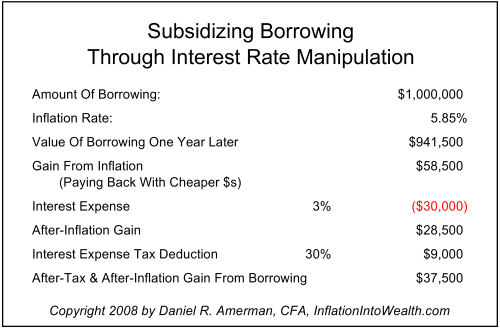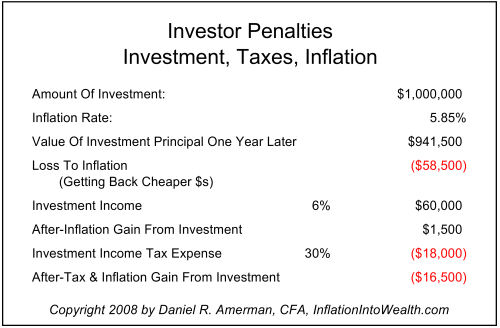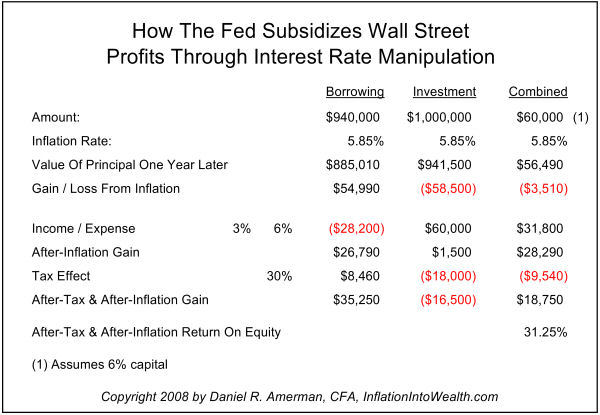 Articles Articles |
Daniel R. Amerman, CFA, InflationIntoWealth.com
A manipulated market is a market that is rife with arbitrage opportunities. In this article we will examine a federally sponsored market manipulation that is currently happening on a massive scale. The Federal Reserve has forced short-term borrowing and investment rates down to levels well below the rapidly rising rate of inflation. By taking this desperate measure to inflate the money supply, even as the Producer Price Index hits a 26 year high and the Consumer Price Index hits a 17 year high, the Fed is making clear its true priorities – it will destroy the value of the dollar and sacrifice the long term value of people’s savings, rather than allow Wall Street to feel the full pain of the mistakes and greed that led to the subprime debacle.
As explained in the article, this intervention also has the effect of reducing real investor yields across almost all financial asset categories, effectively cheating small investors for the benefit of major investors. For those individual investors who are knowledgeable, this quite deliberate manipulation can be turned from a net worth danger into a potentially lucrative arbitrage opportunity, as introduced at the end of the article.
(This is the second article in the 24 Reasons Why Inflation Will Trump Deflation series, and contains Reasons 3-4. While the first article would be helpful, this article also works fine on a stand-alone basis.)
The official year-on-year wholesale inflation rate from January of 2007 through January of 2008 was 7.4%, as measured by the Producer Price Index. This is the largest year-on-year change in 26 years, indeed, the highest measure since the bad old days (for the value of the dollar) of the 1970s and early 80s.
The official year-on-year retail inflation rate from January of 2007 through January of 2008 was 4.3%, as measured by the change in the Consumer Price Index. This followed a 4.1% CPI rise for the year 2007, which was the highest annual CPI change in 17 years.
These two numbers pretty much speak for themselves as being Reason Three for why Inflation Will Trump Deflation. We’re not talking theory about what may happen over the next several years – these are taken from the headlines about what is happening right now.
| Click Here To Learn About A Free Mini Course That Will Teach You How To Turn Inflation Into Wealth. |
Whether the rate of inflation as experienced by the average person is higher than the official rate is another question altogether (as discussed in the article “Inflation Index Manipulation”). However, we don’t need to go there now, as the official rates are bad enough, so for this article we will use 5.85% as our inflation rate, which is the average of the annual CPI and PPI rates above.
Let's step back and take a big picture look at what the Federal Reserve is currently doing. The Federal Reserve controls the supply of money. The Fed is concerned that (quite justifiable) fears of recession – and the still unfolding subprime crisis – will lead to a contraction in the money supply, as lenders decline to make loans. The Fed was already making money available on extraordinarily cheap terms: the Fed funds rate started 2008 at 4.25% percent, and therefore the cost of funds was already 1.60% below the blended inflation rate. In other words, taking the inflation rate into account, we were already in a situation where the government was paying people to borrow. (The precise 4.3% CPI and 7.4% PPI January numbers were of course not known in late January of 2008 – but those are annual numbers, and almost all the monthly components were known at that time.)
However, that was not good enough for a nervous financial system. So the Fed took the extraordinary step of lowering the cost of borrowing to 3%, which placed it a full 2.85% below the official blended inflation rate (and much lower still below what many people believe to be real inflation rates). In effect, what the Fed is saying is:

“Take our money. Please take our money! If free isn't good enough, how about if we pay you to borrow money? In fact, here's what we'll do. If you will borrow $1 million from us, we will let you pay us back with only $941,500, next year. In other words, we'll pay you $58,500, which is the difference between the value of the million dollars you borrow today, and the value of the million dollars with which you will pay us back a year from now (after extrapolating the last 12 months of blended inflation). Now, we will ask you to pay us $30,000 in interest (3% on one million). But that's not all bad! Because we will let you deduct the $30,000 in interest expenses, which could save you $9,000 in taxes (30% combined marginal federal and state). If you take the $58,500 difference in value between what you borrow and what you have to pay back, subtract the $30,000 in interest expense, and then add back the $9,000 in tax savings on the interest expense -- that means that we are paying you a net of $37,500 on an after-inflation and after-tax basis. All you have to do in exchange is to agree to take the use of this million dollars off our hands for a year.
‘Won't you please, PLEASE take the money?"
(Yes, 3% is an overnight rate and not an annual rate, but the principles are easier to understand if we annualize. There are many complexities we do not have the room to go into this article intended for the general public, instead we are concentrating on the impact upon investors.)
This extraordinary market manipulation is Reason Four for why Inflation Will Trump Deflation. As discussed in the first article in the series, the number one factor in resolving the inflation versus deflation debate is government willpower. Is the government willing to trash the currency in order to break deflationary pressures? The United States government’s answer is unmistakable and is dominating the current markets. Faced with the greatest surge of inflation this nation has seen in decades, the Fed is responding not by trying to dampen inflation, but by throwing gasoline on the fire. It is forcing borrowing rates well below the rate of inflation and thereby flooding the system with additional money – inflationary consequences be damned. A symbolic currency that rarely even takes physical form can only have long-term value if it is resolutely defended by the government. In today’s markets, however, it is the government that is leading the attack on its own currency.
There are some quite direct costs to investors from this massive and ongoing market manipulation. One cost is that with just about any interest-bearing asset that you buy, you are getting cheated out of the market rate of interest. A market rate of interest is what a consensus of the buyers and sellers in the market would agree is a fair rate, where an investor thinks they are getting a fair return.
In a market that was independent of deliberate manipulations, in a market where we had close to a 6% official annual rate of inflation, in a market where risk is rising fast and we don't know if bond insurers can pay their claims or if ratings are worth the paper they are written on, in a market of huge federal deficits and even larger trade deficits, where the United States cannot pay its bills either domestically or internationally, and in a market where the just retired chief comptroller of the United States was telling anyone who would listen that the government can't pay its retiree promises… I think we can be confident that the market rate is nowhere even close to 3%. If you as an investor are only getting 3%, then you are getting cheated.
A more fundamental way of understanding the true costs to an investor of this interest rate manipulation, is to look at the return spreads for the investors who are in the market. You as an individual investor, as well as the Wall Street firms, are all investing in expectation of a positive return. As fellow buyers, you are effectively in competition with each other, where the high bid gets the asset. The difference between you is that as an individual who is simply buying assets, you are investing with the reasonable expectation that you will be able to deduct inflation, take out any expected losses in the investment category you're purchasing, take out taxes, and still come out ahead.

The problems with this approach are succinctly illustrated in the chart above, which assumes that an investor earns a 6% return, with the same 5.85% inflationary environment we assumed for our subsidized borrowing chart. The issue with your 6% investment return is twofold. First, the purchasing power of your $1 million investment fell by $58,500, meaning your real profit (after-inflation) was only $1,500. Moreover, that is a pre-tax profit, and your tax-bill is based upon the entire $60,000 in nominal income. Whoops. So after subtracting $18,000 in taxes based upon a combined marginal tax rate of 30%, the ending after-tax and after-inflation results of buying a 6% investment in a time of 5.85% inflation, is a loss of $16,500 in real terms, or 1.6% of our starting $1 million investment.
(This brief summary assumes a basic understanding of the principles of inflation taxes. If you found it hard to follow, or it was a new perspective for you, then the articles “Seizing Your Assets” and “Real Investment Taxes Are 256% Higher” that are contained within the “Turning Inflation Into Wealth” mini-course may be helpful to you.)
So the investment results are poor for an ordinary investor if he or she buys an asset under the conditions illustrated. But what happens with that same investment if you are a major Wall Street firm whose capital base and profits are in need of propping up, and you are receiving an interest rate subsidy courtesy of the Federal Reserve? To understand the liability-based bailout of Wall Street that is underway right now, you need to understand the chart below:

What this chart does is take the previous two charts and combine them, with a Wall Street firm taking out a subsidized borrowing, and using it to purchase the same asset our individual investor purchased. Indeed, the entries in the “Investment” column are identical to the investor chart, but we have slightly modified the borrowing chart by dropping the amount borrowed to $940,000, meaning 6% ($60,000) of the investment purchase is coming from equity (All the major financial firms are highly leveraged).
When we combine the results from the borrowing and investment, since the investment is slightly larger than the borrowing, the Wall Street firm does take a small, $3,510 hit (0.4%) to its net worth from inflation alone. However, the $60,000 in income from the investment does exceed the subsidized, 3% interest cost on $940,000 by $31,800, which leaves a real, pre-tax income of $28,290 after inflation. The ability to deduct subsidized interest rates that are negative in real terms (below the inflation rate) then provides a $28,200 shelter to the firm, which reduces tax expenses by $8,460.
Bottom line? By using the Federal Reserve subsidy, and purchasing the identical investment the individual investor buys, and achieving the identical investment results, the Wall Street firm achieves an after-tax and after-inflation return on equity of a sizzling 31.25% ($18,750 / $60,000 equity investment). The identical investment results that produced a 1.6% real loss for an individual investor, produce a 31.2% gain for the subsidized major corporation.
The consequences of manipulating short-term market rates then ripple out to effect the prices of all other financial assets. In every market, you as an investor are competing against firms who can borrow at the Fed funds rate, who are effectively being paid to borrow. That means – unless you are being paid to borrow, you cannot compete with these firms. For their subsidized source of funds means they can achieve after-tax and after-inflation positive returns at a much lower level than you can, meaning they can afford to pay more.
It is this paying more for assets that constitutes much of the purpose behind this massive, bold, and unmistakable manipulation. The government has a vested interest in keeping financial asset price levels propped up well above where they would otherwise be. If you are out there as an asset only investor in financial assets and you are competing for yield against the investors who are being effectively subsidized by the federal government, that means that you will be systematically overpaying for just about any asset that you buy.
Incidentally, there is another name for all financial assets becoming overvalued: asset inflation. When the Federal Reserve intervenes to keep asset values above what they would otherwise be, then price is higher than value. Another way of putting this is that in exchange for devaluation of the purchasing power of your money through liability subsidies, you get to pay substantively higher prices for the investments you buy.
Life isn’t fair.
That pretty well sums up our first conclusion. Life in the investment world is a particularly unfair place when the big boys get desperate. And they are desperate. Which means that perhaps you shouldn’t be buying financial assets.
The second conclusion is that in reality the world is a very different place than the supremely rational world that is presented by so many columnists and advisors. You know, that calm and placid place where long term returns on asset classes endlessly repeat, for those who simply buy, hold and diversify. The real world is that the powers that be in the financial and political world are playing games with not just the money supply and investment valuations, but with the very nature of money, the likes of which the world has never seen before. Meaning that nothing is certain and everything is at risk.
Third is that if the price of financial assets is being manipulated, then we should buy tangible assets instead. By tangible assets, we mean something you can reach out and touch, something that has an existence independent of computers and legal documents. Therefore, something the supply of which cannot be easily manipulated. Classic examples include gold, silver, other metals and minerals, and real estate. Another tangible asset that is likely to continue to grow in importance in this 21st century is energy.
Our fourth conclusion is that if someone offers to pay you so you will use their money – you should accept. If the Fed is bailing out Wall Street, and the direct bailout is not on the asset side – but the liability side – then the most rational strategy to pursue is to play the liability side for yourself.
But that doesn’t mean you play the same game as Wall Street. There is an alternative, and that is to use the gift that the Federal Reserve is offering to you, but with a different goal. Yes, you still want to be paid to borrow money, and yes, you want tax advantages. However, instead of increasing your risk through Wall Street type leverage, you want to decrease your overall portfolio and lifestyle risk, while still increasing your after-inflation and after-tax rate of return.
Anchor your assets in the hard reality of tangible assets, and then carefully construct an asset/liability hedge that will not increase your risks – but will decrease the risk to your real net worth in an uncertain future. Use a strategy that is designed to profit from inflation, and create inflation tax shelters instead of paying inflation taxes. Build a skew into your strategy so your upside is much larger than your downside.
Put all of this together and you do have the opportunity to take this current manipulation of the money supply, and use it to create an extraordinarily profitable personal arbitrage strategy. Assuming, that is, you have the knowledge to put that strategy together. Which means that learning more about how these factors all work together is the first and most important step in taking your personal arbitrage strategy from theory to applied reality.
Do you know how to Turn Inflation Into Wealth? To position yourself so that inflation will redistribute real wealth to you, and the higher the rate of inflation – the more your after-inflation net worth grows? Do you know how to achieve these gains on a long-term and tax-advantaged basis? Do you know how to potentially triple your after-tax and after-inflation returns through Reversing The Inflation Tax? So that instead of paying real taxes on illusionary income, you are paying illusionary taxes on real increases in net worth? These are among the many topics covered in the free “Turning Inflation Into Wealth” Mini-Course. Starting simple, this course delivers a series of 10-15 minute readings, with each reading building on the knowledge and information contained in previous readings. More information on the course is available at InflationIntoWealth.com .
Contact Information:
Daniel R. Amerman, CFA
Website: http://InflationIntoWealth.com/
E-mail: mail@the-great-retirement-experiment.com
This website contains the ideas and opinions of the author. It is a conceptual exploration of financial and general economic principles. As with any financial discussion of the future, there cannot be any absolute certainty. What this website does not contain is specific investment, legal, tax or any other form of professional advice. If specific advice is needed, it should be sought from an appropriate professional. Any liability, responsibility or warranty for the results of the application of principles contained in the website, readings, and book, either directly or indirectly, are expressly disclaimed by the author.